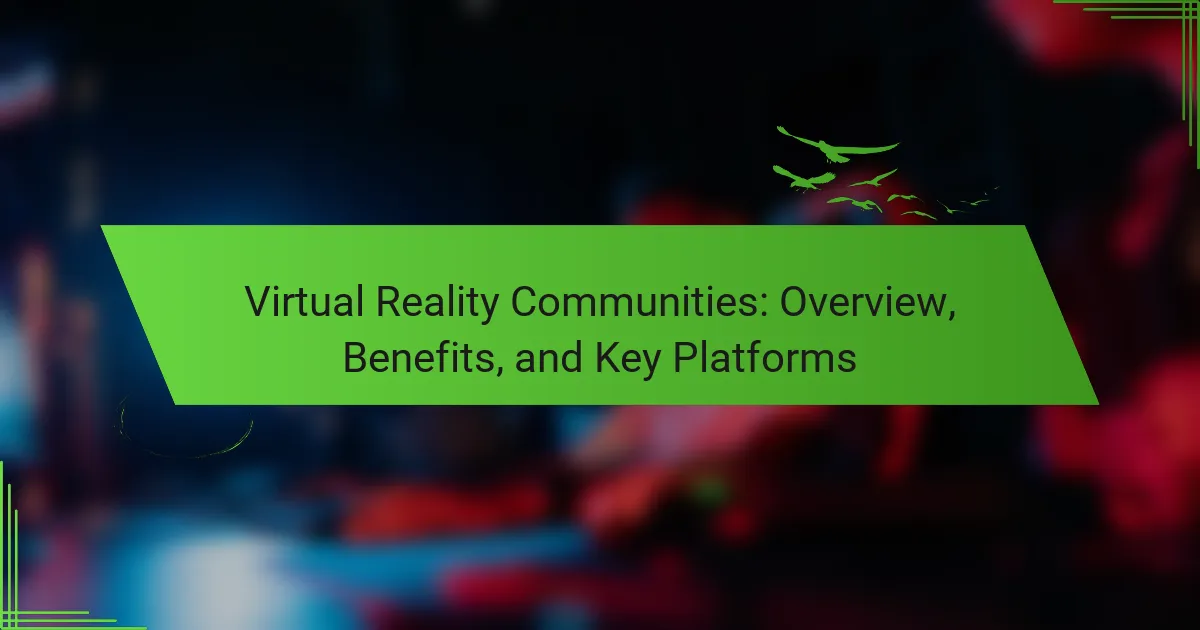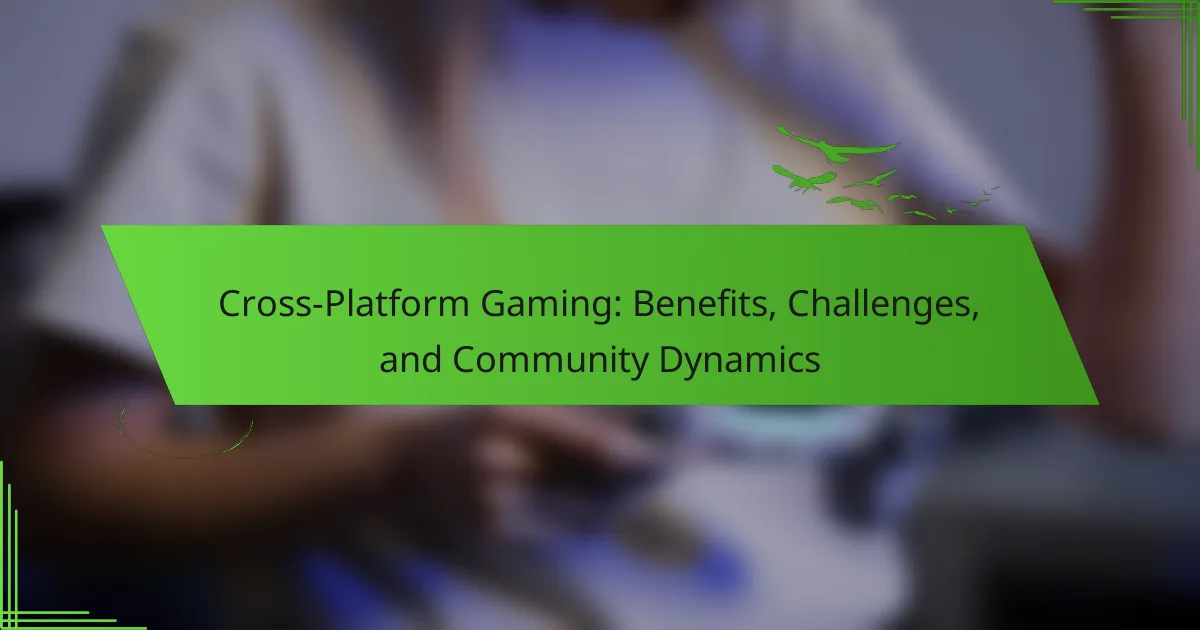Virtual reality communities enhance social interaction and collaboration through immersive experiences and customizable environments. This article explores the benefits of these communities, key platforms like Oculus and VRChat, and the impact of cultural differences on user experiences. Additionally, it addresses challenges users may face, such as technical issues and content moderation. Engaging actively and respecting community guidelines can maximize enjoyment and connection within these spaces.
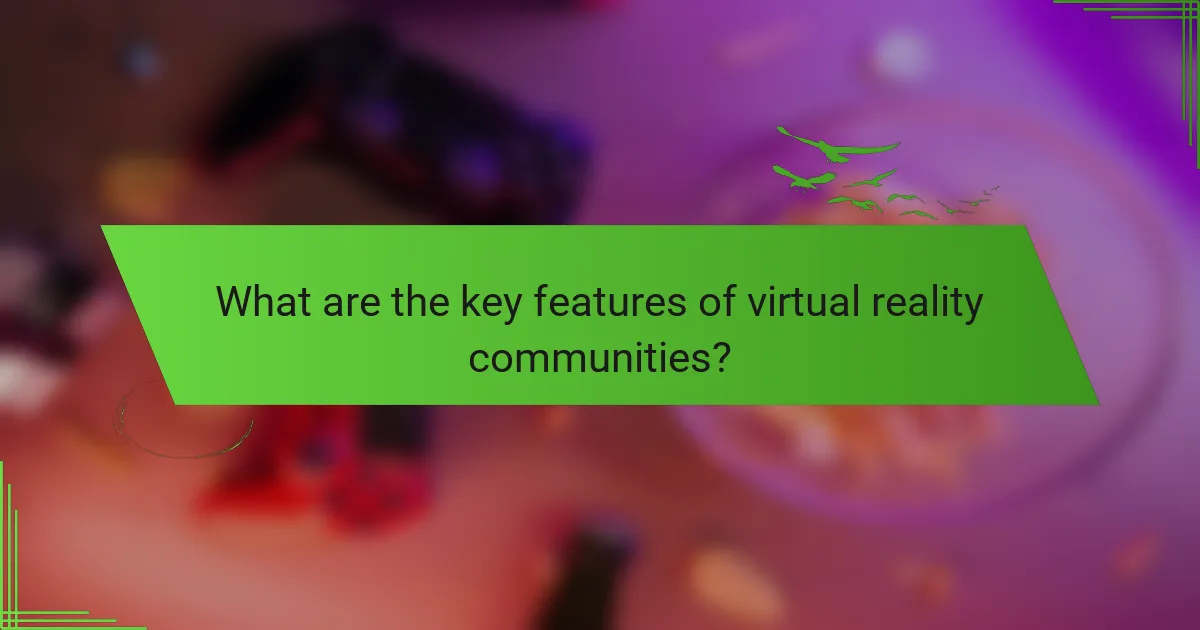
What are the key features of virtual reality communities?
Virtual reality communities offer immersive social interactions, shared experiences, and collaborative environments. Key features include customizable avatars, virtual spaces, user-generated content, and real-time communication. These elements enhance user engagement and foster a sense of belonging. Additionally, platforms often provide tools for content creation, enabling users to shape their environments and experiences uniquely.
How do virtual reality communities enhance social interaction?
Virtual reality communities significantly enhance social interaction by providing immersive environments for users to connect. These platforms foster a sense of presence and engagement, allowing individuals to share experiences in real-time. Users can participate in activities, attend events, and collaborate on projects, which strengthens relationships and builds community ties. The unique attribute of virtual reality is its ability to simulate physical presence, making interactions more meaningful compared to traditional online communication. As a result, users often report increased feelings of belonging and support within these communities.
What role does user-generated content play in these communities?
User-generated content significantly enhances engagement and community building in virtual reality communities. It fosters creativity, allowing users to share experiences, create immersive environments, and establish social connections. This content often reflects unique attributes of the community, showcasing diverse perspectives and interests. Additionally, user-generated content serves as valuable feedback for developers, guiding improvements and innovations in VR platforms.
Which technologies are integral to the functioning of virtual reality communities?
Virtual reality communities rely on several key technologies for their functionality. These include immersive hardware like VR headsets, interactive software platforms, and networking protocols that enable social interaction. Additionally, graphics rendering engines enhance the visual experience, while haptic feedback devices provide tactile sensations, making interactions more realistic.
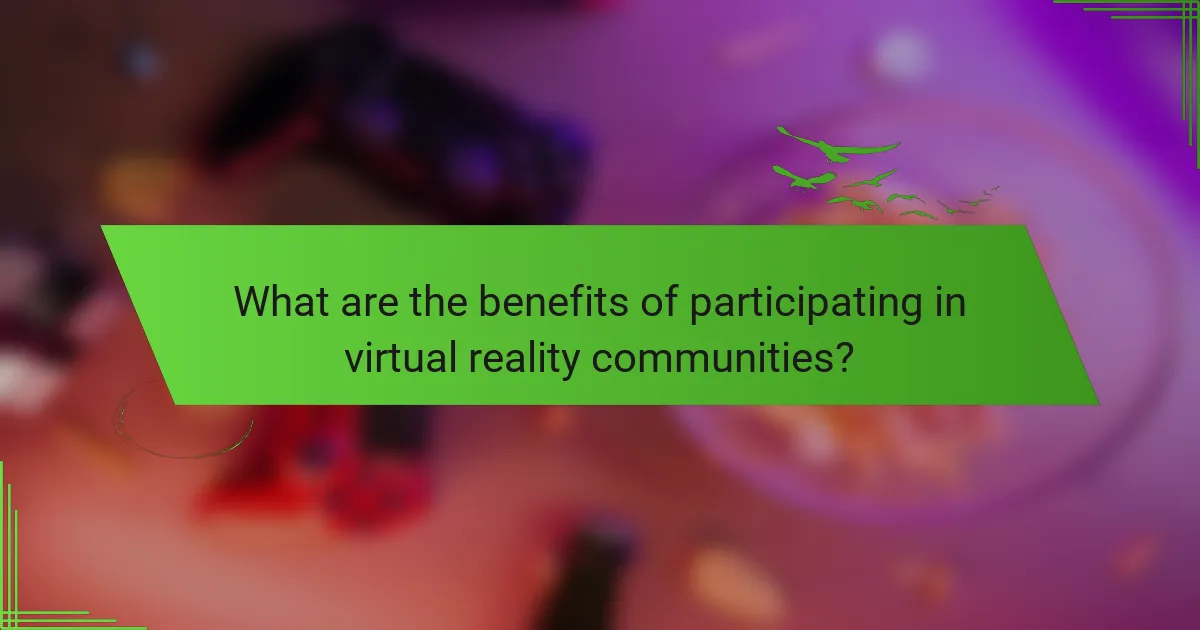
What are the benefits of participating in virtual reality communities?
Participating in virtual reality communities offers numerous benefits, including enhanced social interaction, immersive experiences, and access to diverse content. These communities foster collaboration, creativity, and learning among members. As a result, users can build meaningful connections and engage in shared interests. Additionally, virtual reality communities often provide unique opportunities for skill development and networking.
How do virtual reality communities foster creativity and collaboration?
Virtual reality communities enhance creativity and collaboration by providing immersive environments for interaction. Users can brainstorm, design, and share ideas in real-time, fostering innovation. The unique attribute of these platforms is their ability to simulate physical presence, making collaboration feel more personal. As a result, participants report increased engagement and motivation, leading to more productive creative outcomes.
What mental health benefits can be gained from engagement in these communities?
Engagement in virtual reality communities can significantly enhance mental health by fostering social connections, reducing feelings of isolation, and providing immersive therapeutic experiences. Participants often report increased feelings of belonging and improved emotional well-being. Virtual environments can also facilitate exposure therapy for anxiety and phobias, offering a controlled space for individuals to confront fears. Additionally, these communities can promote mindfulness and relaxation through engaging, interactive activities that distract from stressors.
How do virtual reality communities support educational experiences?
Virtual reality communities enhance educational experiences by fostering collaboration and immersive learning. These platforms allow users to engage in interactive simulations, access diverse resources, and connect with peers globally. For instance, VR environments can simulate historical events or scientific phenomena, facilitating deeper understanding. As a result, learners benefit from experiential education that traditional methods may not provide.
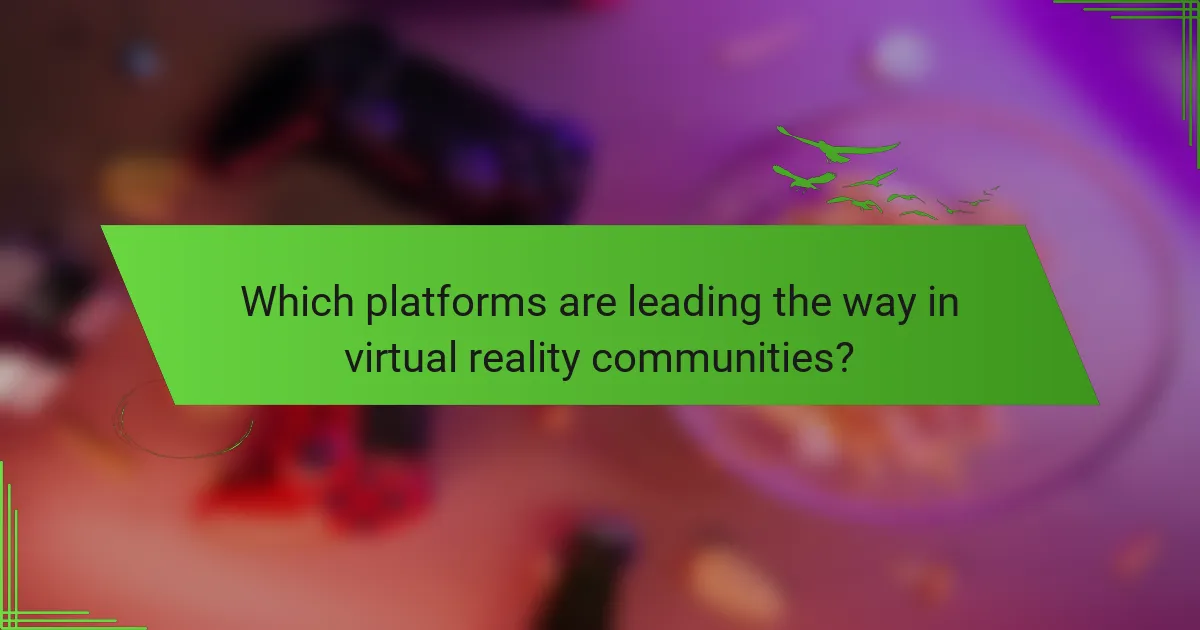
Which platforms are leading the way in virtual reality communities?
Leading platforms in virtual reality communities include Oculus, SteamVR, VRChat, AltspaceVR, and Rec Room. These platforms facilitate immersive social interactions and experiences. Oculus offers extensive content libraries, while SteamVR provides a diverse range of games. VRChat excels in user-generated content and community events. AltspaceVR focuses on live events and gatherings. Rec Room emphasizes creativity and multiplayer games, attracting a broad audience. Each platform enhances virtual reality engagement through unique features and community-driven initiatives.
What distinguishes popular platforms like VRChat and Rec Room?
VRChat and Rec Room differ primarily in user experience and community engagement. VRChat emphasizes social interaction and user-generated content, allowing for extensive customization. Rec Room focuses on casual gaming experiences, offering structured games and activities. VRChat supports a wider range of virtual environments, while Rec Room provides a more guided experience with its game rooms. Both platforms foster community but cater to different user preferences and engagement styles.
How do platform-specific features enhance user experiences?
Platform-specific features significantly enhance user experiences in virtual reality communities by providing tailored interactions and immersive environments. These features, such as social integration, customizable avatars, and unique content offerings, foster deeper engagement among users. For instance, platforms like VRChat allow users to create and share custom worlds, enhancing creativity and connection. Additionally, the ability to interact with friends in real-time amplifies the sense of presence, making experiences more memorable. Overall, these features contribute to a dynamic community atmosphere, encouraging participation and collaboration.
Which emerging platforms are gaining traction in 2025?
Virtual reality communities are gaining traction on platforms like Meta’s Horizon Worlds, VRChat, and AltspaceVR in 2025. These platforms offer immersive social experiences, enabling users to interact in shared virtual spaces. Key benefits include enhanced social connection, creative expression, and collaborative opportunities. As user engagement increases, these platforms are evolving to incorporate more interactive features and user-generated content.
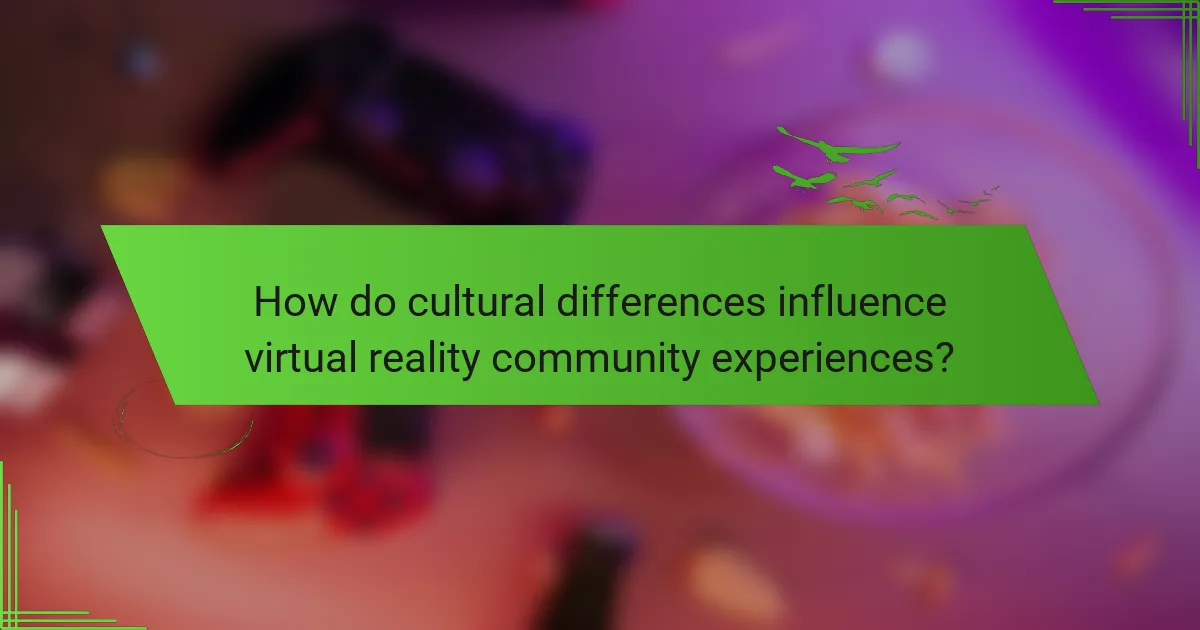
How do cultural differences influence virtual reality community experiences?
Cultural differences significantly shape virtual reality community experiences by influencing interaction styles and content preferences. Diverse backgrounds affect communication norms, leading to varying levels of engagement and collaboration.
For instance, collectivist cultures may prioritize group activities, while individualistic cultures might emphasize personal achievements. These dynamics create unique community environments, fostering either inclusivity or competition.
Additionally, language barriers can impact user experiences, as participants may struggle to connect if they do not share a common language. As a result, VR platforms must adapt to accommodate diverse cultural contexts, enhancing accessibility and user satisfaction.
What unique attributes can be found in virtual reality communities across different regions?
Virtual reality communities exhibit unique attributes influenced by regional cultures and technological access. For example, communities in North America often emphasize gaming and social interaction, while those in Asia may focus on education and immersive experiences. Additionally, cultural factors shape content creation and user engagement, leading to distinct community norms and values. Access to advanced technology also varies, impacting community growth and participation.
How do language and cultural norms shape interactions in these communities?
Language and cultural norms significantly shape interactions in virtual reality communities by influencing communication styles and social dynamics. These factors can enhance collaboration, foster inclusivity, and create shared experiences. For example, language can dictate the level of engagement and understanding among participants. Cultural norms often dictate behavior, etiquette, and the way individuals express themselves, impacting group cohesion and interaction quality. Additionally, unique attributes of specific communities, such as gaming cultures or artistic environments, further define interaction patterns.
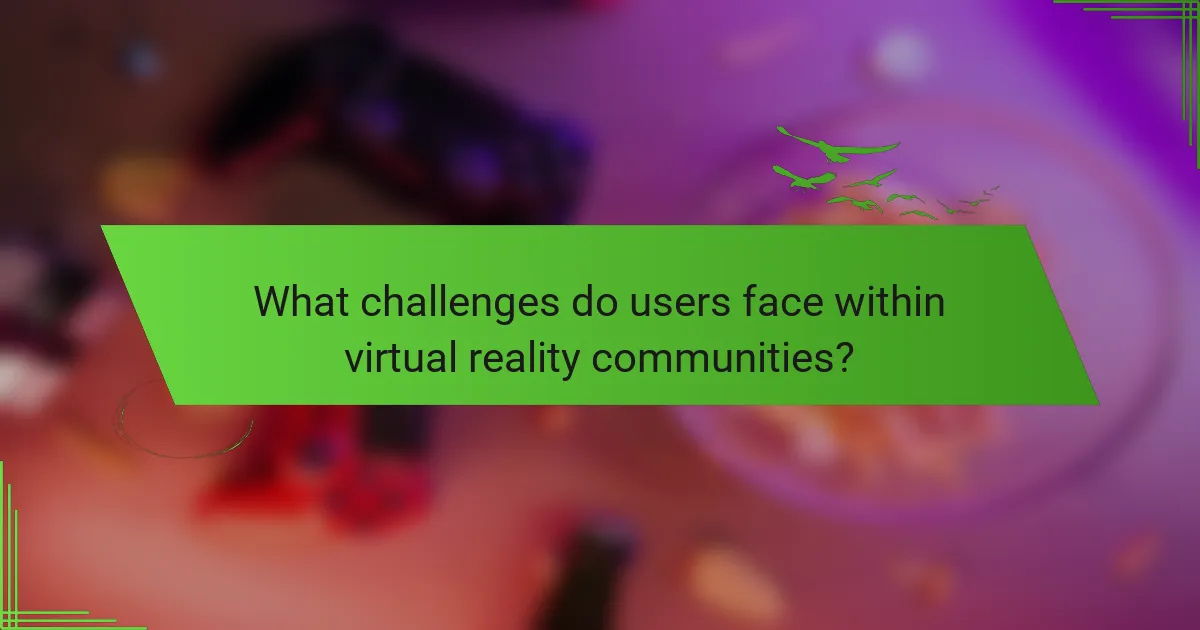
What challenges do users face within virtual reality communities?
Users in virtual reality communities face challenges such as technical issues, social dynamics, and content moderation. Technical difficulties include hardware compatibility and connectivity problems, which can hinder the user experience. Social dynamics often involve navigating diverse user interactions, which may lead to misunderstandings or conflicts. Content moderation is crucial for maintaining a safe environment, yet it can be inconsistent, leading to concerns about harassment or inappropriate content. These challenges impact user engagement and overall satisfaction within these communities.
How can issues of moderation and safety be effectively addressed?
Moderation and safety in virtual reality communities can be effectively addressed through clear guidelines and active monitoring. Establishing community standards helps set expectations for behavior. Implementing reporting mechanisms allows users to flag inappropriate content or actions. Regular moderation by trained staff ensures adherence to guidelines. Additionally, user education on safety practices fosters a more secure environment. These strategies promote healthy interactions and reduce risks within virtual spaces.
What are the common technical barriers users encounter?
Users commonly encounter technical barriers in virtual reality communities, including hardware limitations, software compatibility issues, and high bandwidth requirements. These challenges can hinder user experience and accessibility. For instance, many users lack access to high-performance VR headsets or powerful computers needed for optimal performance. Additionally, inconsistent software updates can lead to compatibility problems across different platforms. Finally, poor internet connectivity can affect online interactions and content streaming within these communities.
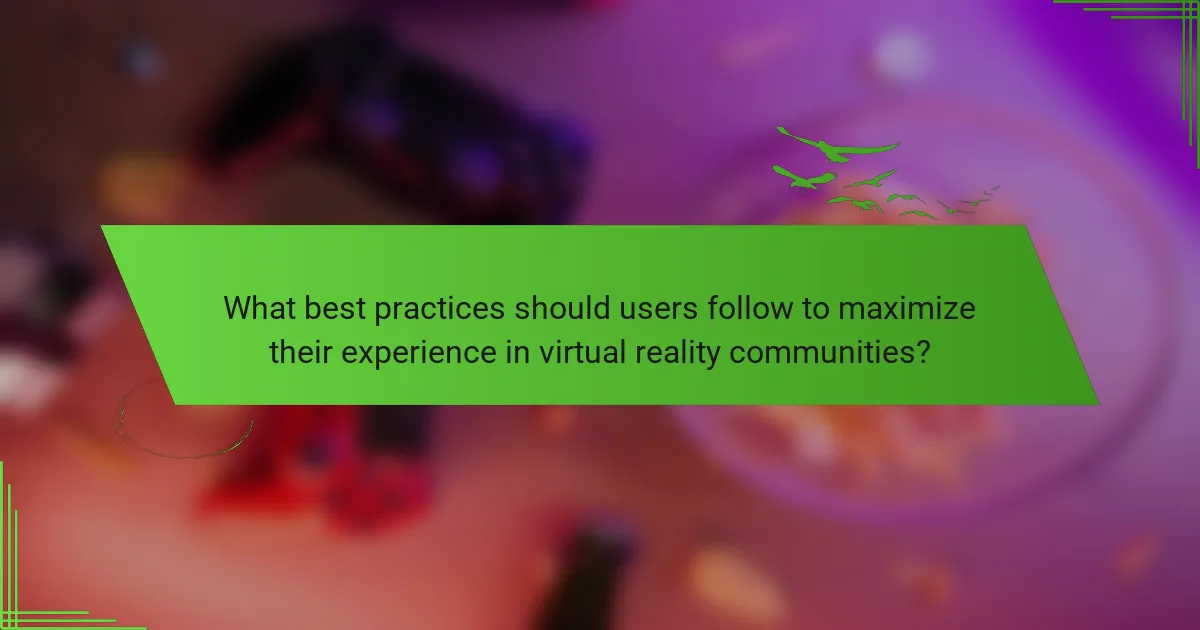
What best practices should users follow to maximize their experience in virtual reality communities?
To maximize their experience in virtual reality communities, users should engage actively, respect community guidelines, and explore diverse content. Active participation fosters connections and enhances enjoyment. Respecting guidelines ensures a positive environment and encourages constructive interactions. Exploring various content types, such as games, discussions, and events, broadens understanding and enjoyment of the community.
How can users effectively build connections within these communities?
Users can effectively build connections within virtual reality communities by actively participating in discussions, attending events, and collaborating on projects. Engaging with community members fosters relationships and enhances the overall experience. Joining specialized groups based on interests can also lead to more meaningful interactions. Additionally, utilizing social features of platforms like avatars and messaging tools can facilitate deeper connections.
What strategies can enhance user engagement and satisfaction?
Engaging users in virtual reality communities can be enhanced through immersive experiences, social interactions, and user-generated content. These strategies foster a sense of belonging and encourage active participation.
1. Create immersive experiences: Utilize high-quality graphics and interactive elements to captivate users.
2. Facilitate social interactions: Implement features like voice chat and collaborative activities to strengthen connections.
3. Encourage user-generated content: Allow users to create and share their own content, enhancing community involvement.
4. Provide regular updates: Keep the platform dynamic with new features, events, and content to maintain user interest.
5. Gather feedback: Actively solicit user input to improve the platform and address community needs.
